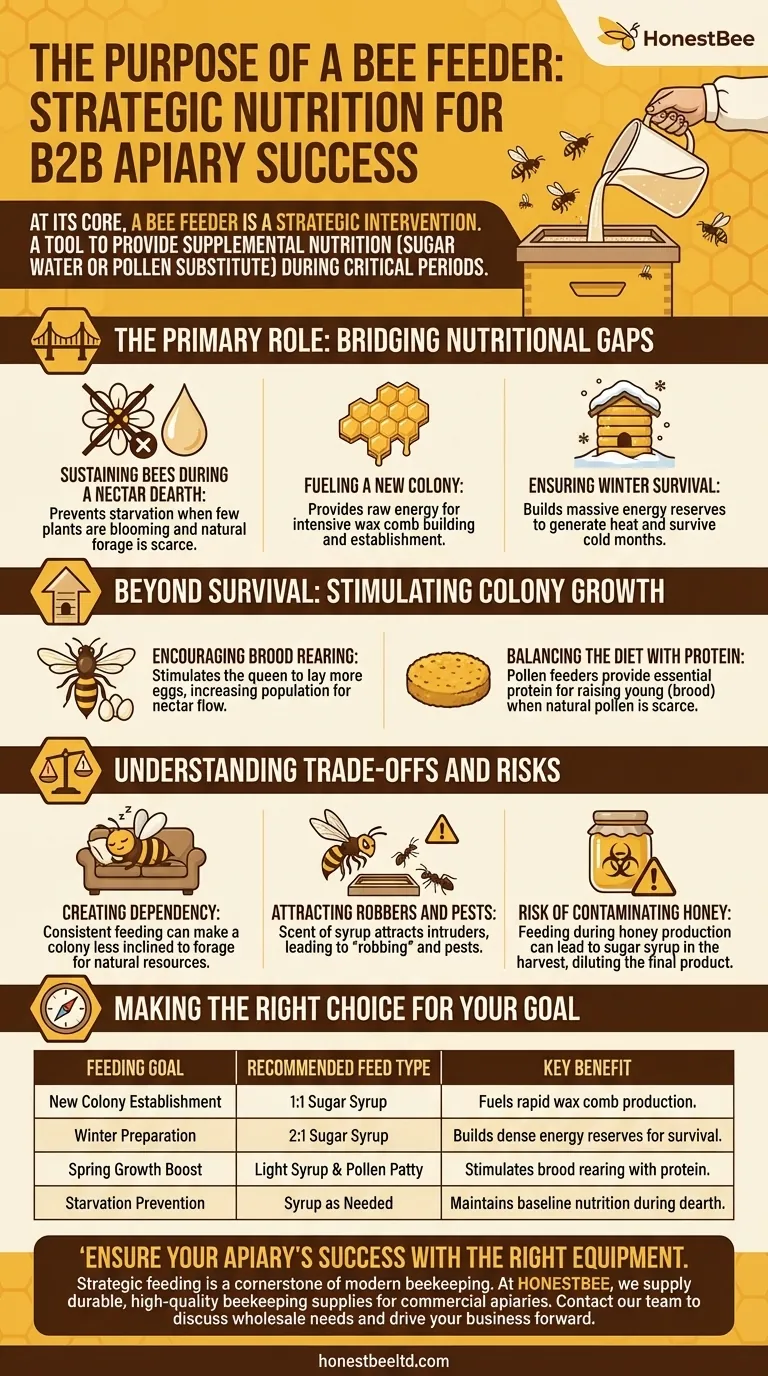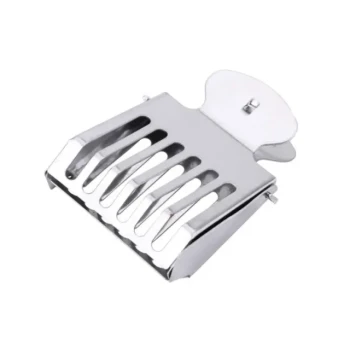At its core, a bee feeder is a strategic intervention. It is a tool beekeepers use to provide supplemental nutrition—typically sugar water or a pollen substitute—to a honeybee colony. This is done during critical periods when natural forage is scarce, ensuring the bees have the energy and nutrients required for survival, growth, and critical hive functions like building comb and raising young.
A bee feeder is not merely a food bowl; it is a management tool that allows a beekeeper to strategically bridge nutritional gaps in the environment, directing a colony's energy towards specific goals like establishment, winter preparation, or rapid population growth.

The Primary Role: Bridging Nutritional Gaps
A honeybee colony's success is directly tied to the availability of nectar (carbohydrates) and pollen (protein and fats) from flowering plants. When these natural resources are unavailable, a feeder becomes essential.
Sustaining Bees During a Nectar Dearth
A nectar dearth is a period when few or no plants are blooming. Feeders filled with sugar syrup provide the carbohydrates necessary to prevent the colony from consuming its winter stores or, in worst-case scenarios, starving.
Fueling a New Colony
A newly installed colony has a monumental task: building an entire city of wax comb from scratch. They have no honey reserves. Providing sugar syrup gives them the raw energy required for this intensive wax production, allowing them to build the structures needed to store food and raise brood.
Ensuring Winter Survival
Colonies need massive stores of honey to generate heat and survive the cold months. If a colony hasn't stored enough food by the fall, beekeepers will feed a heavy sugar syrup to ensure they have sufficient reserves to make it to spring.
Beyond Survival: Stimulating Colony Growth
Strategic feeding can also be used to actively encourage and accelerate a colony's development. It sends a powerful signal to the hive that resources are abundant.
Encouraging Brood Rearing
A steady inflow of what bees perceive as "nectar" stimulates the queen to lay more eggs. This is particularly useful in early spring to build the colony's population in time for the main nectar flow.
Balancing the Diet with Protein
Sugar syrup only provides carbohydrates for energy. Bees also need protein, which they get from pollen, to raise their young (brood). A pollen feeder provides a nutritional substitute during times when natural pollen is scarce, ensuring the colony can continue to raise the next generation of bees.
Understanding the Trade-offs and Risks
While essential, feeding is an intervention that carries potential downsides that every beekeeper must manage.
Creating Dependency
Consistent feeding can make a colony less inclined to forage for natural resources. It should be used as a supplement to, not a replacement for, what nature provides.
Attracting Robbers and Pests
The scent of sugar syrup can attract bees from other hives, leading to "robbing," where intruders fight to steal the food stores. This can overwhelm and destroy a weaker colony. It also attracts pests like ants and wasps.
Risk of Contaminating Honey
Feeding sugar syrup while bees are actively producing honey that will be harvested is a critical mistake. This can lead to bees storing sugar syrup in the honeycomb, diluting the final product and creating something that cannot be legally or ethically called honey.
Making the Right Choice for Your Goal
Using a feeder effectively means matching the type of feed to the colony's specific, immediate need.
- If your primary focus is establishing a new colony: Provide a 1:1 sugar-to-water syrup to simulate a light nectar flow and fuel rapid comb building.
- If your primary focus is preparing a colony for winter: Use a thicker 2:1 sugar-to-water syrup in the fall to help them quickly store dense energy reserves.
- If your primary focus is boosting a weak colony in early spring: Offer a pollen patty in addition to light syrup to provide the protein needed for raising new brood.
- If your primary focus is preventing starvation during a dearth: Provide syrup only as needed to ensure the colony has a baseline of food without making them dependent.
Ultimately, a bee feeder is a beekeeper's tool for managing a colony's energy and nutrition, ensuring it doesn't just survive, but actively thrives.
Summary Table:
| Feeding Goal | Recommended Feed Type | Key Benefit |
|---|---|---|
| New Colony Establishment | 1:1 Sugar Syrup | Fuels rapid wax comb production |
| Winter Preparation | 2:1 Sugar Syrup | Builds dense energy reserves for survival |
| Spring Growth Boost | Light Syrup & Pollen Patty | Stimulates brood rearing with protein |
| Starvation Prevention | Syrup as Needed | Maintains baseline nutrition during dearth |
Ensure your apiary's success with the right equipment.
Strategic feeding is a cornerstone of modern beekeeping, and having reliable, high-quality feeders is non-negotiable for commercial success. At HONESTBEE, we supply beekeeping supplies and equipment specifically designed for the demands of commercial apiaries and distributors.
We understand that your goals are focused on efficiency, colony health, and maximizing honey production. Our wholesale-focused operations ensure you get the durable, effective equipment you need to manage nutritional gaps and drive your business forward.
Ready to equip your operation for peak performance? Contact our team today to discuss your wholesale needs and discover the HONESTBEE difference.
Visual Guide

Related Products
- Professional Hive Front Entrance Bee Feeder
- HONESTBEE Professional Hive Top Bee Feeder Feeding Solution
- HONESTBEE Entrance Bee Feeder Professional Hive Nutrition Solution for Beekeeping
- Classic Boardman Entrance Bee Feeder Hive Front Feeding Solution
- Professional Hive Top Bee Feeder for Beekeeping
People Also Ask
- How to make an entrance feeder for bees? A DIY Guide for Safe & Effective Feeding
- What is an entrance feeder? A Guide to Its Simple Design and High Robbing Risk
- How does an entrance feeder work? A Guide to Its Simple Mechanics and Risks
- How do you make an entrance feeder for bees? A Guide to Safe & Effective Hive Feeding
- How does a beehive entrance feeder work? A Simple Guide to Supplemental Feeding



















